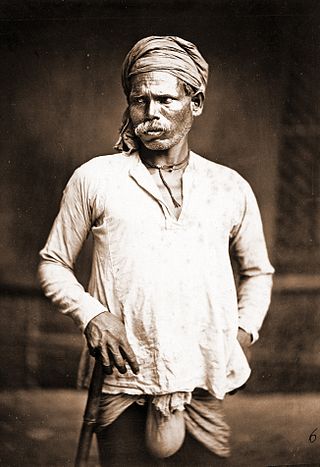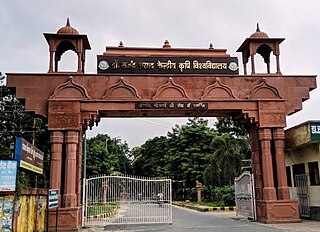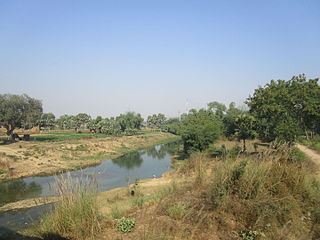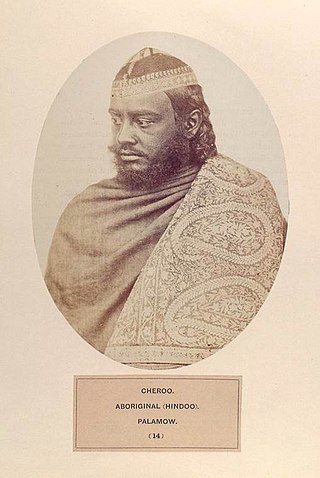Related Research Articles

Bihar is a state in Eastern India. It is the third largest state by population, the 12th largest by area, and the 15th largest by GDP in 2021. Bihar borders Uttar Pradesh to its west, Nepal to the north, the northern part of West Bengal to the east, and Jharkhand to the south. Bihar is split by the river Ganges, which flows from west to east. On 15 November 2000, southern Bihar was ceded to form the new state of Jharkhand. Only 11.27% of the population of Bihar lives in urban areas as per a 2020 report. Additionally, almost 58% of Biharis are below the age of 25, giving Bihar the highest proportion of young people of any Indian state. The official language is Hindi, which shares official status alongside that of Urdu. The main native languages are Maithili, Magahi, Bhojpuri, Angika, Bajjika and Surjapuri. But there are several other languages being spoken at smaller levels.
The Other Backward Class (OBC) is a collective term used by the Government of India to classify communities that are "educationally or socially backward". It is one of several official classifications of the population of India, along with general castes, Scheduled Castes and Scheduled Tribes. The OBCs were found to comprise 52% of the country's population by the Mandal Commission report of 1980 and were determined to be 41% in 2006 when the National Sample Survey Organisation took place. There is substantial debate over the exact number of OBCs in India; it is generally estimated to be sizable, but many believe that it is higher than the figures quoted by either the Mandal Commission or the National Sample Survey.

The Dom, also known as Domra, Domba, Domaka, Dombara and Dombari, are castes, or groups, scattered across India. Dom were a caste of drummer. According to Tantra scriptures, the Dom were engaged in the occupations of singing and playing music. Historically, they were considered an untouchable caste called the Dalits and their traditional occupation was the disposal and cremation of dead bodies. They are in the list of Scheduled caste for Reservation in India in the Indian states of Uttar Pradesh, Bihar, Odisha, Andhra Pradesh, Jharkhand and West Bengal.

Samastipur is one of the thirty-eight districts of Bihar in India. The district headquarters are located at Samastipur. The district occupies an area of 2904 km² and has a population of 4,261,566.

Arwal district is one of the thirty-eight districts of Bihar state, India, and Arwal town is the administrative headquarters of this district. It was earlier part of Jehanabad district.

Aurangabad district is one of the thirty-eight districts of Bihar state, India. It is currently a part of the Red Corridor.

Lakhisarai district is one of the thirty-eight districts of Bihar state, India, and Lakhisarai town is the administrative headquarters of this district. Lakhisarai district is a part of Munger Division. The district occupies an area of 1,228 km2 (474 sq mi).
Sisai is one of the biggest villages in the Indian state of Bihar. It comes under Siwan District, located about 42 km by road and 52 km by train route north of Chhapra. It is a typical village of Bihar. It is the biggest village in Siwan. It has 51 tola. It comes under Goriyakothi Police Station and Sisai Panchayat. There is a famous middle school which was built in 1916. It is bounded by Chhitaouli from North, Bishunpur from South, Angya from East and Pahlejpur from West.

Chamar is a community classified as a Scheduled Caste under modern India's system of affirmative action that originated from the group of trade persons who were involved in leather tanning and shoemaking. They are found throughout the Indian subcontinent, mainly in the northern states of India and in Pakistan and Nepal.
Bihari is a demonym given to the inhabitants of the Indian state of Bihar. Bihari people can be separated into three main Indo-Aryan ethnolinguistic groups, Bhojpuris, Maithils and Magadhis. They are also further divided into a variety of hereditary caste groups. In Bihar today, the Bihari identity is seen as secondary to caste/clan, linguistic and religious identity but nonetheless is a subset of the larger Indian identity. Biharis can be found throughout India, and in the neighbouring countries of Nepal, Pakistan and Bangladesh. During the Partition of India in 1947, many Bihari Muslims migrated to East Bengal. Bihari people are also well represented in the Muhajir people of Pakistan because of Partition.
At the 2011 Census, Bihar was the third most populous state of India with total population of 104,099,452, nearly 89% of it rural. It was also India's most densely populated state, with 1,106 persons per square kilometre. The sex ratio was 918 females per 1000 males. Almost 58% of Bihar's population was below 25 years age, which is the highest in India. At 11.3%, Bihar has the second-lowest urbanisation rate in India after Himachal Pradesh.
The Dhanuk is an ethnic group found in India. In Bihar where they are significantly present, they have been categorised as the "lower backwards", along with several other castes constituting 32% of the state's population. In recent times they have been identifying themselves with the Kurmi caste along with the Mahto of Chhotanagpur. In Bihar, they are considered as a sub-caste of the Mandal caste and are often found using Mandal surname. In recent times, there has been attempt to forge a socio-political alliance between them and the twin castes of Koeri and the Kurmi, as a part of Luv-Kush equation.
The Kewat, also spelled Kevat, is a Hindu caste, found in the states of Assam, Bihar, Tripura, Uttar Pradesh and West Bengal in India. They are the traditional boatmen of northern India, and also in neighbouring country Nepal.
The Lal Begi, or Lalbegi, or Lala Baig are a Chuhra caste found in the states of Bihar and Uttar Pradesh in India, as well as in Multan, Dera Ghazi Khan and Bahawalpur in Pakistan.

The Chero is a caste found in the states of Bihar, Jharkhand and Uttar Pradesh in India.
The Bhuiyan or Bhuiya are an indigenous community found in the Indian states of Bihar, Jharkhand, Madhya Pradesh, Odisha, Uttar Pradesh and West Bengal. They are not only geographically disparate but also have many cultural variations and subgroups.

Chapra is an assembly constituency in Saran district in the Indian state of Bihar. In 2015 Bihar Legislative Assembly election, Chapra was one of the 36 seats to have VVPAT enabled electronic voting machines.

Kalyanpur is an assembly constituency in Samastipur district in the Indian state of Bihar. The seat is reserved for scheduled castes.
Afazalpur Dhobghati Saidpur is a village in Bihar, India.

Bhabua is one of 243 constituencies of legislative assembly of Bihar. It comes under Sasaram Lok Sabha constituency.
References
- ↑ "Population of Scheduled Castes in Bihar" (PDF). SC&ST Welfare Department, Government of Bihar . 2012.